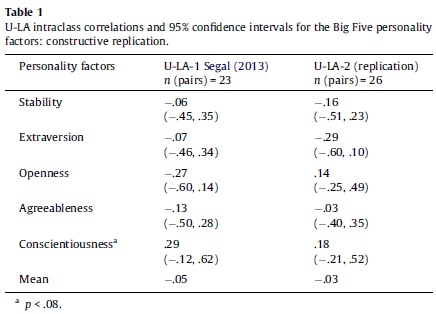
Read this neat NYT write-up of new research by Nancy Segal and co-authors. Segal, famous for her work on twins, got an idea when she encountered the oeuvre of Francois Brunelle, “a photographer in Montreal who takes pictures of pairs of people who look alike but are not twins”:
When [Segal] saw the photographs, she realized
that the unrelated look-alikes would be ideal study subjects: She could
compare their similarities and differences to those of actual twins.[…]
For Dr. Segal’s initial study,
she asked Mr. Brunelle to send questionnaires to some of his subjects,
and she received completed forms from 23 pairs of unrelated look-alikes.
The questionnaires yield a score based on five personality measures:
stability, openness, extroversion, agreeableness and conscientiousness.
The participants also took the Rosenberg Self-Esteem Scale…[…]
For a second study,
she teamed with a skeptic, Ulrich Ettinger, a psychologist at the
University of Bonn in Germany who had heard about the look-alike project
during a postdoctorate at the University of Montreal.“I
thought that if two people looked alike, they would have similar
personality traits because people would treat them the same,” he said.
“For example, I thought men who looked alike and were tall and handsome
would probably be extroverts.”Their
analysis was consistent with the findings of Dr. Segal’s first study:
Personality traits do not appear to be influenced by the way people are
treated because of appearance.
Typical personality correlations for identical twins are .5. Here are the combined results from both studies of Unrelated Look-Alikes, reported in Segal, Graham, and Ettinger (Personality and Individual Differences, 2013):
Though fascinating, this approach isn’t quite as convincing as studies of socially mis-identified twins. Whatever you think, don’t miss Brunelle’s pictures; they boggle the mind.
HT: Nathaniel Bechhofer

READER COMMENTS
Phil
Aug 28 2014 at 1:12am
Except for the last one (men with berets), none of the pairs really look alike to me, at least in my intuitive sense of guessing their personalities from their facial expressions.
Maybe I’m reading too much into their expressions … so maybe I’d say the same thing for actual twins.
Theodore Sternberg
Aug 28 2014 at 4:45pm
Waaait a minute, how do we know this isn’t faked? Judging from Brunelle’s web site, the pairs of people self-report. So does he verify they’re not just putting him on? It seems like, between Brunelle’s interest in being a famous photographer and the subjects’ amusement with the process, no one has much of an interest in verification.
Besides that, the subjects have obviously made the effort to get coiffed and dressed the same, and put on similar expressions.
This reminds me of the early-20th Century studies on (real) identical twins raised separately (which were used for nature-vs-nurture type research), in which it turned out that “raised separately” was often very liberally interpreted.
So, in the absence of further information, I remain skeptical on this.
Comments are closed.